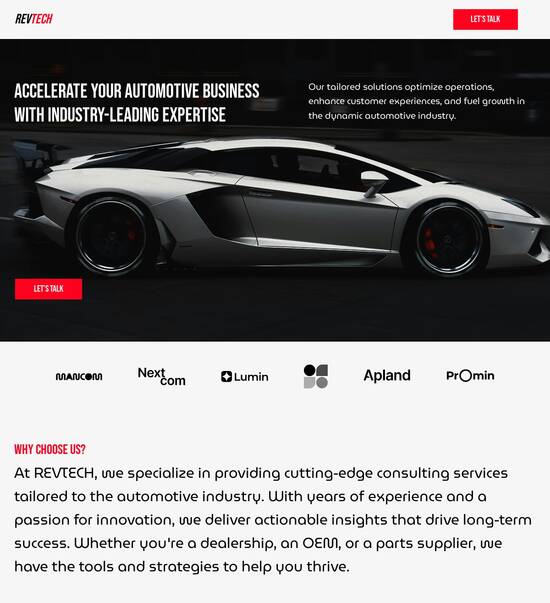
Under construction page template compatible with Drupal
Explore Similar TemplatesAbout template
Build and integrate high-converting under construction page templates with Drupal effortlessly!
Recommended templates

Easy to build without coding
With the intuitive drag-and-drop builder, anyone on your team can create high-converting pages without any knowledge of code or design. Make enhancements to your landing page with custom widgets using Javascript, HTML/CSS, or third-party scripts.

Multiple layouts for any industry and goal
Select from 500+ landing page layouts built to boost conversions across industry-specific scenarios. Customize them by adjusting fonts, adding images, and generating on-brand content with the AI assistant. Quickly scale with Instablocks® and Global Blocks that you can save, reuse, and update globally.

Loads fast and looks polished on any device
Every template is responsive, which means they present professionally on any device and load blazingly fast with our Thor Render Engine. You can also power them up with Google AMP technology to deliver an unparalleled mobile experience and drive higher conversions.

Robust analytics & experimentation
Get real-time updates and reporting across all your devices, showing the number of visitors, conversions, cost-per-visitor, and cost-per-lead. Launch AI-powered experiments, run A/B tests, and use heatmaps to analyze user behavior, then optimize your landing page to maximize conversions.







Easy to build without coding
With the intuitive drag-and-drop builder, anyone on your team can create high-converting pages without any knowledge of code or design. Make enhancements to your landing page with custom widgets using Javascript, HTML/CSS, or third-party scripts.
Multiple layouts for any industry and goal
Select from 500+ landing page layouts built to boost conversions across industry-specific scenarios. Customize them by adjusting fonts, adding images, and generating on-brand content with the AI assistant. Quickly scale with Instablocks® and Global Blocks that you can save, reuse, and update globally.
Loads fast and looks polished on any device
Every template is responsive, which means they present professionally on any device and load blazingly fast with our Thor Render Engine.
Robust analytics & experimentation
Get real-time updates and reporting across all your devices, showing the number of visitors, conversions, cost-per-visitor, and cost-per-lead. Launch AI-powered experiments, run A/B tests, and use heatmaps to analyze user behavior, then optimize your landing page to maximize conversions.
All the features you need to build lead-generating landing pages
Explore more featuresLearn how to build top-performing landing pages for any goal
FAQs
Leading the way in building high-performing landing pages





A comprehensive step-by-step guide to using Instapage for effective landing page creation
Instapage's powerful landing page and conversion rate optimization (CRO) capabilities make it a top choice for marketers aiming to enhance their digital campaigns. This guide helps you navigate through the various features and functionalities of Instapage, ultimately maximizing your return on investment.
Understanding the power of Instapage
Instapage offers everything you need to create landing pages that convert. With its extensive library of over 100 high-converting templates and intuitive elements for lead generation, marketers in business services, tech/SaaS, and education can easily launch optimized pages tailored to their specific audience needs.
- 100+ ready-to-use templates: Instapage provides a vast array of templates that are optimized for conversions, saving you valuable design time.
- Lead gen elements: Build forms, pop-ups, and call-to-action buttons seamlessly integrated into your pages, enhancing user engagement.
- No coding required: The drag-and-drop interface allows teams of any size to create beautiful landing pages without the need for a developer.
Step 1: Building your landing page
Creating a landing page on Instapage is straightforward. Start by choosing a template that resonates with your target audience. The platform provides design options for various sectors including energy & utilities and financial services.
Step 2: Optimize for conversions
Optimization is key to achieving high conversion rates. With Instapage's built-in experimentation features and analytics dashboard, marketers can understand user behavior and refine their pages.
- A/B testing tools: Test different versions of your pages to see what resonates most with your audience.
- Heatmaps: Visualize where users are clicking to optimize page layout.
- Performance analytics: Gain insights into page performance and make data-driven decisions.
Step 3: Collaborate effectively
Collaboration is essential for maximizing production efficiency. Instapage allows for real-time editing and instant feedback, making it a robust platform for marketing teams looking to streamline their process.
- Real-time feedback: Team members can leave comments and suggestions directly on the landing pages.
- Secure sharing options: Easily share pages with stakeholders for review before going live.
- Edit collaboratively: Teams can work together in real-time, ensuring swift adjustments.
By confidently utilizing these features, marketers can create and manage landing pages that not only attract visitors but convert them into leads and customers.
Ready to transform your marketing strategy? Explore Instapage today and start creating landing pages that truly perform.
People also ask about Under construction page template compatible with Drupal
Under construction page template compatible with Drupal
Understanding the importance of an 'under construction' page
An 'under construction' page serves as a placeholder for a website that is either being built or undergoing maintenance. This simple yet effective webpage informs visitors that the main website is currently unavailable, but will be live soon. It functions not only as a communication tool, but also as a way to set expectations regarding the website's usability.
This type of page is commonly used in web development, particularly when new sites are being launched or significant updates are being made. The page can mitigate user frustration, diverting attention while notifying users of the pending launch. Common use cases also include when websites change ownership or are shifting to new branding strategies.
Launching a new website or blog
Implementing major design updates or structural changes
Rebranding or changing ownership of a site
Why it matters for your web presence
Having an 'under construction' page is crucial for maintaining user engagement during downtime. Visitors appreciate communication about the unavailability of the website, which enhances their perception of the brand's professionalism. This engagement can be sustained by providing them with updates or an estimated timeline for when the site will be live.
Another important aspect is managing user expectations regarding the project timelines. By specifying a launch date or milestones, you can create anticipation. Furthermore, SEO considerations should also be taken into account; this means using appropriate meta tags to inform search engines about your page status, helping your site maintain its ranking even if it's temporarily offline.
Exploring Drupal: a robust platform for your website
Drupal is a highly versatile content management system (CMS) that empowers users to build complex websites with ease. Its modular architecture allows developers to extend its capabilities through additional plugins and themes. This flexibility makes it an ideal choice for any type of project, from personal blogs to large enterprise portals.
Some key features of Drupal include a user-friendly interface, robust security measures, and a strong emphasis on scalability. Users also benefit from a thriving community that contributes numerous resources, including forums, tutorials, and plugin options. Its rich content taxonomy system enables easy content organization and management.
Robust security features that protect against common vulnerabilities like SQL injection.
A flexible theme engine that allows for customization of website appearance.
Scalability that supports growth, allowing websites to expand as needed.
Why choose Drupal for your 'under construction' needs?
Drupal's scalability ensures it can support sites of varying sizes, making it ideal for business needs that may grow over time. Utilizing a CMS like Drupal allows for quick updates and deployment, crucial for maintaining user interest during your site's downtime. Additionally, its robust security features ensure that sensitive information remains protected, including during the transition to a new design.
Another contributing factor to choosing Drupal is its flexibility regarding themes. You can easily implement various visual styles that align with your brand and match your intended user experience. This adaptability ensures your 'under construction' page not only looks professional but also supports your broader branding efforts.
Crafting an effective 'under construction' page template
When creating an 'under construction' page template in Drupal, certain essential elements must be included to ensure it is both functional and visually appealing. First, it’s crucial to incorporate branding elements like your logo and a distinct color scheme that reflects your brand identity. This visual consistency will help maintain the connection in visitors' minds between the temporary page and your main website.
Additionally, the acknowledgment message should be clear, expressing gratitude for visitors' patience. Estimated launch dates should also be included to manage expectations effectively. Contact information is vital, allowing users to reach out with inquiries, while social media links can help keep them connected with your brand's updates.
Branding elements including logo and color scheme.
Acknowledgment message expressing gratitude.
Estimated launch date for transparency.
Contact information for inquiries.
Social media links for ongoing engagement.
Innovative features to enhance user experience
Incorporating innovative features can significantly enhance the user experience on your 'under construction' page. Countdown timers, for instance, create a sense of urgency and anticipation for the website launch, impacting user engagement positively. Additionally, email subscription forms can capture visitor information, keeping them informed and engaged as the launch date approaches.
You might also consider adding progress updates or blog segments to share development milestones, allowing users to follow the build process. Interactive elements like polls or social sharing options can further engage users, inviting them to participate in the excitement of the upcoming launch.
Building your template in Drupal: a step-by-step guide
To start building your 'under construction' page template, you'll want to choose the right theme. Look for lightweight and responsive themes that are easy to customize. This will not only improve user experience but also ensure compatibility across various devices, enhancing accessibility.
When evaluating themes, consider their customization options. Certain themes may offer drag-and-drop functionality, which can streamline the development process. Research community ratings and reviews to gauge ease of use and future maintenance requirements.
Select lightweight, responsive themes for optimal performance.
Consider themes with strong community support and documentation.
Evaluate customization options like drag-and-drop builders.
Customizing your web page with design elements
Once you have chosen a theme, you can begin customizing your web page layout. Start with setting up your page structure, which includes header, footer, and main content areas. Each section should be thoughtfully planned for a clear user journey, integrating your chosen branding elements seamlessly.
Incorporating visual elements like images or videos can create a more engaging experience for your visitors. Well-placed visuals can draw attention to key messages while breaking up text-heavy areas. Utilize Drupal blocks to manage dynamic content, allowing for easy updates in the future without disturbing the overall page structure.
Set up the page structure: header, content, footer.
Add visual elements strategically to enhance engagement.
Use Drupal blocks for easy management of dynamic content.
Integrating SEO best practices into the under construction page
Don't overlook the importance of SEO when setting up your 'under construction' page. Utilize meta tags and HTML tags to convey necessary information to search engines, ensuring they understand that your site is under construction but will be live soon. This can assist in preserving your website's search rankings.
Make sure to use alt text for images to boost accessibility and provide context to search engines. Proper URL structures should also be considered; keeping your URLs concise and relevant aids in maintaining a good SEO standing.
Finalizing and deploying your under construction page
Before launching, it's essential to ensure compliance with coding standards. Double-check that any PHP or JavaScript used conforms to best practices. Pay close attention to the mobile responsiveness of your page, as a significant number of users access the internet through mobile devices. Use tools like Google’s Mobile-Friendly Test to evaluate the effectiveness of your design.
Successful testing also involves troubleshooting common issues. Look out for broken links, misaligned elements, and loading times. Various performance testing tools, such as GTmetrix or Pingdom, can help identify areas that need adjustment before going live.
Review coding standards for PHP and JavaScript.
Check for mobile responsiveness using testing tools.
Use performance testing tools to identify potential issues.
Launching your page: what to expect
Once your page is live, monitor user engagement closely. Use analytics tools to assess traffic and interaction rates on your 'under construction' page. This valuable data will inform you about visitor behavior and help fine-tune your strategy for the full website launch.
Feedback is also essential. Don't hesitate to collect user thoughts on the experience while waiting for the launch. Consider incorporating feedback into your development plans, ensuring that your active site meets user expectations more effectively.
Post-launch considerations for your website
Transitioning from an 'under construction' page to an active site requires meticulous planning. Begin by preparing for content migration. It’s important to have a solid plan that ensures seamless transfer and integration of existing content and any new elements that will enrich your site.
Informing users about the full site launch is also pivotal. Use email notifications and social media channels to update your audience. Consider reinforcing their excitement with sneak peeks of features or exclusive content on the new site.
Plan content migration to transfer all elements smoothly.
Communicate full site launch updates via email and social media.
Offer sneak peeks or exclusive content to return users.
Long-term engagement strategies
After your site has launched, long-term engagement strategies should be a priority. Start by maintaining a subscriber list gathered from your 'under construction' page. This group of interested visitors can provide valuable insight into content preferences, engagement levels, and response to updates.
Utilizing analytics tools will allow you to track user behavior on your site post-launch. Monitoring areas such as page visits, click-through rates, and session durations will give you a clearer picture of what is working and what can be improved. Leveraging this information protects against stagnation and promotes continual growth.
Potential packages and services for ongoing support
Consider the potential need for continuing support after launching your website. Engaging with Drupal development agencies can provide invaluable expertise in maintaining and enhancing your site over time. These professionals can assist with ongoing technical support, custom development, and tailored updates based on user feedback.
Furthermore, investing in training resources for your team ensures that everyone is equipped with the knowledge needed to manage and operate the site efficiently. Workshops, online tutorials, and community forums can help maintain a well-informed team that understands the platform's capabilities and limitations.
Explore services offered by Drupal development agencies for ongoing technical support.
Invest in training resources to empower your team in managing the website.
Utilize community forums for sharing experiences and learning from others.
Case studies and success stories
Looking at real-world examples can illuminate how effective 'under construction' pages can be planned and executed. Websites that have successfully utilized this strategy often share compelling design choices and informative elements that draw users back. Their engagement metrics post-launch typically show increased traffic driven by anticipation created during the construction phase.
Such case studies can reveal common themes in effective strategies, like strong visual branding paired with clear communication of updates. Additionally, they often provide valuable lessons that can assist others in avoiding pitfalls that might occur during launch. Learning from past successes can help streamline future development efforts.
Analyze featured websites for effective design and content strategies.
Review user engagement metrics to understand the impact of anticipation.
Identify common themes and elements of successful implementations.
Ready to skyrocket conversions?
Supercharge your ad campaigns with high-performing landing pages
Get started














